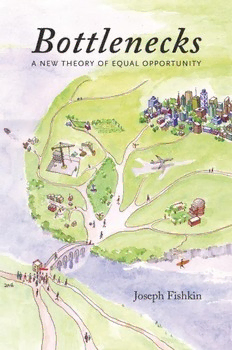Table Of Contentooxxffoorrddhhbb--99778800119999881122114411..iinndddd iiii 1111//2288//22001133 55::0077::2299 PPMM
Bottlenecks
ooxxffoorrddhhbb--99778800119999881122114411..iinndddd ii 1111//2288//22001133 55::0077::2288 PPMM
ooxxffoorrddhhbb--99778800119999881122114411..iinndddd iiii 1111//2288//22001133 55::0077::2299 PPMM
Bott lenecks
A New Theory of Equal Opportunity
JOSEPH FISHKIN
1
ooxxffoorrddhhbb--99778800119999881122114411..iinndddd iiiiii 1111//2288//22001133 55::0077::2299 PPMM
1
Oxford University Press is a department of the University of Oxford.
It furthers the University’s objective of excellence in research, scholarship,
and education by publishing worldwide.
Oxford New York
Auckland Cape Town Dar es Salaam Hong Kong Karachi
Kuala Lumpur Madrid Melbourne Mexico City Nairobi
New Delhi Shanghai Taipei Toronto
With offi ces in
Argentina Austria Brazil Chile Czech Republic France Greece
Guatemala Hungary Italy Japan Poland Portugal Singapore
South Korea Switzerland Th ailand Turkey Ukraine Vietnam
Oxford is a registered trademark of Oxford University Press
in the UK and certain other countries.
Published in the United States of America by
Oxford University Press
198 Madison Avenue, New York, NY 10016
© Oxford University Press 2014
All rights reserved. No part of this publication may be reproduced, stored in a
retrieval system, or transmitt ed, in any form or by any means, without the prior
permission in writing of Oxford University Press, or as expressly permitt ed by law,
by license, or under terms agreed with the appropriate reproduction rights organization.
Inquiries concerning reproduction outside the scope of the above should be sent to the Rights
Department, Oxford University Press, at the address above.
You must not circulate this work in any other form
and you must impose this same condition on any acquirer.
Library of Congress Cataloging-in-Publication Data
Fishkin, Joseph.
Bott lenecks : a new theory of equal opportunity / Joseph Fishkin.
pages cm
Includes bibliographical references and index.
Based on author’s thesis (doctoral—Oxford University, 2009) under title: Opportunity pluralism.
ISBN 978–0–19–981214–1 (hardback :alk. paper) 1. Discrimination—Law and legislation—
United States—Philosophy. 2. Equality—Philosophy. I. Title.
KF4755.F57 2013
342.7308'5—dc23
2013028228
1 3 5 7 9 8 6 4 2
Printed in the United States of America
on acid-free paper
ooxxffoorrddhhbb--99778800119999881122114411..iinndddd iivv 1111//2288//22001133 55::0077::2299 PPMM
CONTENTS
Introduction
1
A. HOW WE THINK ABOUT EQUAL OPPORTUNITY 2
B. OPPORTUNITY PLURA LISM 10
C. IMPLICATIONS OF THE THEORY 18
I. Equal Opportunity and Its Problems
24
I.A. CONCEPTIONS OF EQUAL OPPORTUNITY 25
I.A.1. Rawlsian Equal Opportunity and Starting-Gate
Theories 2 9
I.A.2. Tests, Bias, and “Formal-Plus” 3 2
I.A.3. Luck Egalitarianism and Natural Talents 3 5
I.A.4. Talent, Luck, and Dworkin 3 8
I.B. BEYOND DISTRIBUTIVE JUSTICE: OPPORTUNITIES AND FLOURISHING 41
I.C. FOUR PROBLEMS FOR EQUAL OPPORTUNITY 48
I.C.1. The Problem of the Family 4 8
i. Parental Advantages 4 8
ii. Mitigation and Compensation 51
iii. Families and the Principle of Fair Life Chances 5 3
I.C.2. The Problem of Merit 5 6
i. An Admissions Example 5 7
ii. Merit for Luck Egalitarians 59
iii. Roemer’s EOp Proposal and the Limits of Merit 61
iv. Merit and Self 6 4
v
ooxxffoorrddhhbb--99778800119999881122114411..iinndddd vv 1111//2288//22001133 55::0077::2299 PPMM
vi Contents
I.C.3. The Problem of the Starting Gate 6 5
i. Limits of the Ex Ante Perspective 66
ii. Compounded Advantage and the Concatenation of
Opportunities 7 0
iii. Focus on the Youngest? 72
iv. Them That’s Got Shall Get 7 3
I.C.4. The Problem of Individuality 7 4
i. Schaar’s Nightmare and Nozick’s Dream 74
ii. Toward a Different Kind of Equal Opportunity 7 9
II. Opportunities and Human Development
83
II.A. NATURA L DIFFERENCE IN POLITICAL THEORY 84
II.B. INTRINSIC DIFFERENCES, NATURE, AND NURTURE 88
II.B.1. Intrinsic Difference Claims 8 9
II.B.2. Models of Nature and Nurture 9 1
II.B.3. N ot Even Separate 9 4
II.C. THE TROUBLE WITH “NORMAL” 100
II.C.1. There Is No “Normal” 100
II.C.2. The Flynn Effect: An Object Lesson in the Role of
Environment 103
II.D. AN ITERA TIVE MODEL OF HUMAN DEVELOPMENT 104
II.D.1. Developing Capacities 104
II.D.2. Interaction with Family and Society 108
II.D.3. Interaction with the World of Employment 112
II.E. THE TROUBLE WITH “EQUAL” 115
II.E.1. A Simple Equalization Problem 1 16
II.E.2. What if We Don’t All Have the Same Goal? 119
II.E.3. The Endogeneity of Preferences and Goals 1 21
II.E.4. Essential Developmental Opportunities 1 24
III. Opportunity Pluralism
130
III.A. UNITARY AND PLURA LISTIC OPPORTUNITY STRUCTURES 131
III.A.1. Individuality and Pluralism 132
III.A.2. Positional Goods and Competitive Roles 137
III.A.3. The Anti-Bottleneck Principle 1 44
III.A.4. Who Controls the Opportunity Structure? 151
III.B. THE DYNAMICS OF BOTT LENECKS 156
III.B.1. T ypes of Bottlenecks 156
III.B.2. Legitimate versus Arbitrary Bottlenecks 160
ooxxffoorrddhhbb--99778800119999881122114411..iinndddd vvii 1111//2288//22001133 55::0077::2299 PPMM
Contents vii
III.B.3. Severity of Bottlenecks 164
III.B.4. How Many People Are Affected by this Bottleneck? 1 70
III.B.5. What To Do about Bottlenecks 171
III.B.6. Bottlenecks and the Content of Jobs 1 74
III.B.7. Situating Bottlenecks within the Opportunity Structure as
a Whole 1 77
III.B.8. Bottlenecks, Efficiency, and Human Capital 1 79
III.B.9. Potential Benefits of Bottlenecks 1 83
III.C. FLOURISHING, PERFECTIONISM, AND PRIORITY 186
III.C.1. Equal Opportunity without a Common Scale 188
III.C.2. Thin Perfectionism and Autonomy 193
IV. Applications
198
IV.A. CLASS AS BOTT LENECK 1 99
IV.A.1. Fear of Downward Mobility: A Parable about How
Inequality Matters 2 00
IV.A.2. College as Bottleneck 2 05
IV.A.3. Segregation and Integration: A Story of Networks and
Norms 212
IV.B. FREEDOM AND FLEXIBILITY IN THE WORLD OF WORK 220
IV.B.1. Flexibility, Job Lock, and Entrepreneurialism 2 20
IV.B.2. Workplace Flexibility and Gender Bottlenecks 2 24
IV.C. BOTT LENECKS AND ANTIDISCRIMINATION LAW 231
IV.C.1. S ome Cutting-Edge Statutes and their Implications 2 31
IV.C.2. Whom Should Antidiscrimination Law Protect? 2 35
IV.C.3. An Example: Appearance Discrimination 2 39
IV.C.4. Bottlenecks, Groups, and Individuals 2 44
IV.C.5. How Should Antidiscrimination Law Protect? 2 46
Conclusion 254
Acknowledgments 2 59
Index 261
ooxxffoorrddhhbb--99778800119999881122114411..iinndddd vviiii 1111//2288//22001133 55::0077::2299 PPMM
ooxxffoorrddhhbb--99778800119999881122114411..iinndddd vviiiiii 1111//2288//22001133 55::0077::3300 PPMM

